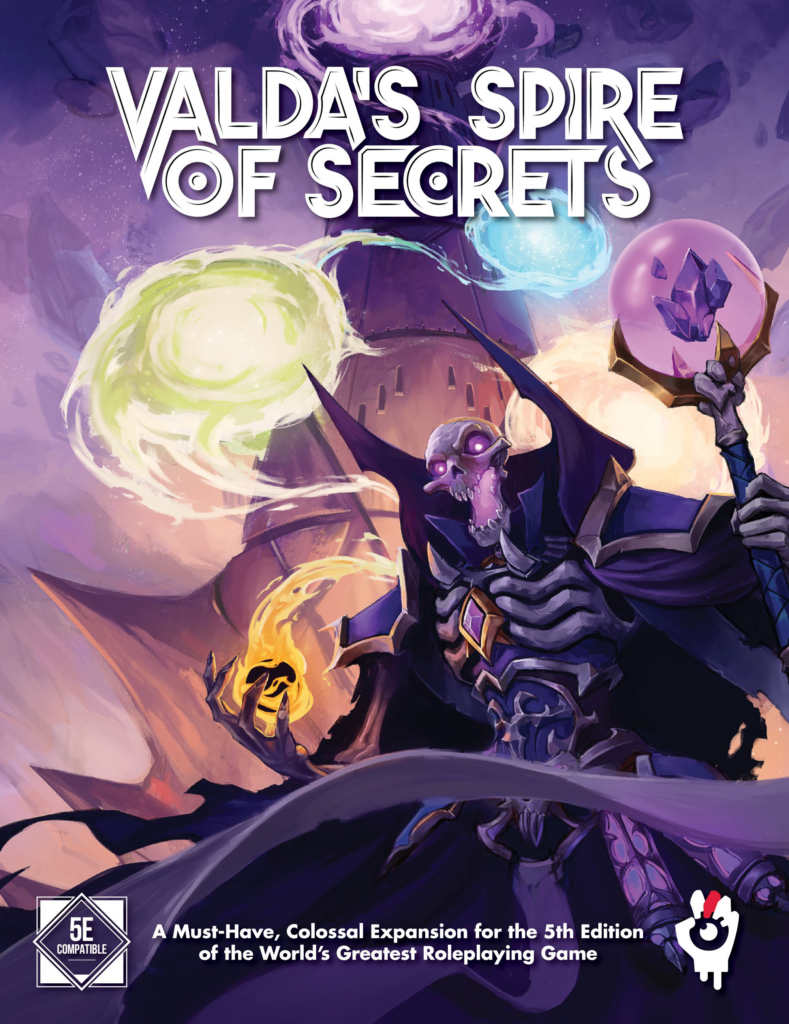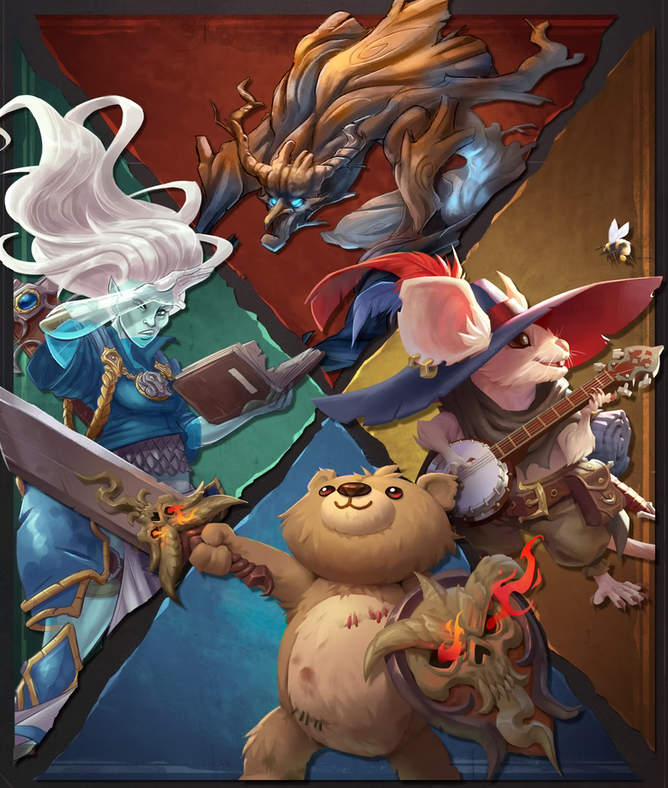In the last days I’ve been browsing the internet with the goal of finding interesting D&D-related material. Eventually I stumbled upon Valda’s Spire of Secrets, an expansion for D&D 5th Edition by Mage Hand Press which includes new races, classes, subclasses, spells, equipment, monsters, magic items, and more. Even though I am planning to keep my D&D 5th Edition game simple by relying mostly on the three core books, I was still tempted to pick it up.
Valda’s Spire of Secrets is a massive tome of 385 pages. At the time of this writing only a pre-release PDF version is available, which I got access to after supporting the project as a late backer on Backerkit. The first impression is great. The artwork is awesome and incredibly charming. The layout is clear and everything is easy to read. The production values are on par with official D&D 5th Edition products.
I haven’t had that much time to delve deeper into the book yet, that’s why I called this article a “quick look”. The idea is to give you an impression on what to expect if you pick up the book yourself without going into too much detail. This isn’t meant as a proper review.
Listing everything the book has to offer would make for a very long post, so let me tell you about the things I like the most.
My favorite race in the book is the Gepettin, which are basically animated toys. The three available subraces are Bisque (a form of porcelain doll), Marionette, and Raggedy (think of a plush bear or any other soft doll). They can be either extremely charming and cute, or unnerving and terrifying. I believe Gepettin characters would be a great fit for a kids game or even something more dark like Curse of Strahd.

When it comes to the ten new classes introduced in this book I am a bit torn. Don’t get me wrong, the classes are all pretty exciting, well written and I can easily imagine settings where they might be a perfect fit. But adding so many classes might lead to the incredible feature and power creep especially D&D 3rd Edition suffered from. Personally I prefer Wizards of the Coast’s approach to stick mostly to the core classes while adding options through subclasses.
If I had to pick my favorite class it would probably be the Investigator class. Members of this class are supernatural detectives and moster slayers. They excel at ritual magic and at level 3 they can be further customized by choosing one of the eight occult specializations. The Antiquarian gets a slew of magical trinkets and relics, the Detective is basically a fantasy version of Sherlock Holmes, while the Occultist gives the Investigator class access to pact magic like a Warlock, just to name a few of the options available. Overall these classes and their subclasses offer an unseen depth of customization.
Another cool concept is the Martyr class which is literally fated to die. Their ultimate class feature is “Final Martyrdom” which they get at level 20 which allows them to die in eternal glory (and a loud bang). When your using this class feature you are immune to all damage for 10 minutes, immune to a slew of status effects, and you can even cast Wish once. After the ten minutes are over, you’ll die – resurrection impossible – so make sure it counts! I can easily see whole campaigns written around a character playing the Martyr class.

The third chapter in Valda’s Spire of Secrets contains six new subclass options for each of the twelve core classes. That’s seventy-two new subclasses! I have to admit that some of these subclasses are very exiting and cool, but there are also a few which will probably not get any use at my game table except for a silly one-shot. Notable is the Path of the Muscle Wizard subclass for the barbarian, which grants the character a slew of abilities which are called “spells” and “magic” but are indeed martial abilities. I’ve posted an example below.
Shocking Grasp. As a bonus action when you make an attack on your turn, you can hit your target even harder than usual, a fact which they will find quite shocking. On a hit, the target can’t take a reaction until the start of your next turn.
Vasha’s Spire of Secrets, page 195
Luckily the number of silly or humorous subclasses is quite limited. Cool subclasses are – in my humble opinion – the “Circle of the City” for druids which give them authority over cityscapes instead of the wilds, the “Mage Hand Magus” fighter which allows them to use an improved mage hand cantrip which can be used to fight and perform special maneuvers, or the “Chrono-Master” rogue subclass which allows the character to mess with time. There’s even a Warlock patron which is actually a future version of the character. Wild!
And if adding ten new classes plus seventy-two subclasses for the core classes wasn’t enough to still your thirst for customization, Valda’s Spire of Secret adds new rules for multiclassing (like auxiliary levels which are basically one-level classes which you can pick to add some flavor) and new feats.

The book contains two extensive chapters containing new equipment and spells. I have to admit I haven’t delved deeper into these chapters yet, but I noted a couple of very exciting magic items which I’ll definitely include in future games.
Valda’s Spire of Secrets concludes with four appendices: variant rules, familiars, monstrous grafts and rules for Siegeball, a full-contact sport. Last but not least there is a custom D&D 5th Edition character sheet.
Wow! Leafing through this book felt a bit like drinking from a fire hose! There’s so much stuff in here that it made my head spin, but your mileage may vary. Don’t get me wrong, I really love this book. It makes me even more excited for 5th Edition, but I am also extremely hesitant to introduce the new classes and subclasses to my game at this point. Especially if you are a new DM it’s hard to gauge what effect adding so many new options has on the game. In fact, there’s one thing this book is really missing: some DM advice on how to use all this material.
But I don’t want to end this post on a negative note. Valda’s Spire of Secrets is probably the only collection of classes, subclasses, spells and equipment you’ll ever need in addition to the three D&D 5th Edition core books. There’s something in there for everyone and the presentation is definitely top notch. If you want to check it out yourself, you can support Mage Hand Press by a Late Pledge on Backerkit. The PDF version of Valda’s Spire of Secrets sets you back $30 or your local equivalent.


